The Outdoors Are for Everyone—Fundamentals of Outdoor Recreation and Trails Accessibility
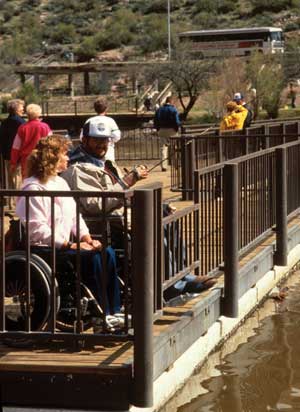
It's all about people having the opportunity to enjoy the outdoors. Public lands offer a wide range of recreation settings and opportunities from highly developed campgrounds to untouched wilderness areas. Visitors may choose both the type of recreation they want to pursue and where to pursue it. Of course, recreationists must always check to make sure that what they want to do is allowed where they want to recreate.
Why Accessibility Is Important
The Forest Service is committed to integrating and maximizing accessibility into the full range of recreation opportunities while protecting natural resources and maintaining the character and experience of the settings so that all people have the opportunity to enjoy the great outdoors. This commitment is established in Forest Service policy.
How does accessibility fit into this range of opportunities? We certainly don't want to pave the wilderness. However, when the decision is made to construct or alter a building, trail, recreation site, or other facility, we must ask, "How can we design, purchase, or build it to ensure all people have an equal opportunity to use this facility?" The key is to ask this question before the facility has been designed and built or purchased. Then we can provide facilities for use by all people.
For more information on Forest Service recreation opportunities, visit http://www.fs.fed.us/recreation/.
How many people benefit from accessible facilities? At the time of the 2010 census, 54 million people (about 1 in every 5 people in the United States) had a disability that significantly limited one or more major life activities, such as walking, seeing, hearing, breathing, and thinking. Of that number, 7 percent used wheelchairs, and 2.1 percent used crutches, canes, walkers, or other assistive devices. Seventy-five percent have disabilities that are not obvious at first glance. People with disabilities constitute the largest minority in the country.
Additionally, the population of the United States is aging. By the year 2030, more than 80 million people will be 65 or older. As people age, impairments are more likely to hinder activities. If you live long enough, you are likely to join the ranks of people with disabilities.
Recreation Opportunities on National Forests and Grasslands
There are national forest and grasslands in all but six of the States and in Puerto Rico and the Virgin Islands.
-
155 national forests and grasslands
-
193 million acres (78.1 million hectares) to enjoy
-
-
439 congressionally designated wilderness areas
-
37.6 million acres (15.2 million hectares) in which to experience solitude and a pristine environment
-
-
156,000 miles (251,000 kilometers) of trails to hike
-
122 wild and scenic rivers
-
4,927 miles (7,929 kilometers) of beautiful water to float or fish
-
-
19,611 recreation sites and 23,000 recreation buildings
-
5,000 campgrounds in which to pitch a tent or set up a trailer or recreational vehicle
-
-
Thousands of miles (or kilometers) of scenic byways to drive
-
172 million visits each year
If anyone in a group has a disability, accessibility is an issue for the whole group (figure 1.) This influences where the group will go and what they will do together. Ski areas learned many years ago that each skier who has a disability is usually accompanied by three or four additional skiers who don't have disabilities. They all want to buy lift tickets, rent gear, eat lunch, and ski together. Accessibility is good customer service and good for business.
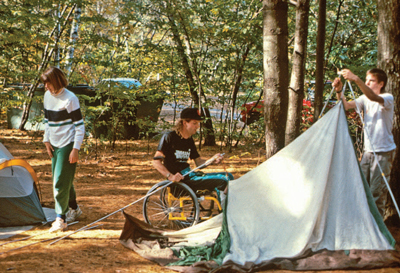
Figure 1—Although the Blackberry Crossing Campground in the White Mountain National Forest is not highly developed, it's a great place for this group of friends to enjoy camping together. Photo credit: Northeast Passage, Durham, NH
Just as recreational preferences vary among the general population, people with disabilities enjoy different types of outdoor recreation. We must make sure that facilities allow all visitors to choose their own recreational activities.
What Terminology Should Be Used?
Although people who have disabilities refer to themselves in many different ways and numerous "buzz words" have been used to describe people with disabilities over the years, direction for terminology was provided in the early 1990s. The 1990 Americans with Disabilities Act (ADA) uses the phrase persons with disabilities and the word accessible. When Section 504 of the Rehabilitation Act of 1973 was renewed and amended in 1992, its terminology was corrected to include accessible and persons with disabilities. Federal agency regulations, policies, and documents have used terminology that matches ADA and the Rehabilitation Act since that time.
A disability is a medically definable condition that causes a limitation in one or more of a person's major life activities, such as walking, seeing, hearing, speaking, breathing, thinking, and so forth. Person-first terminology is used because the person is more important than his or her disability. Examples include:
-
A person who is blind—not "a blind person"
-
A person who uses a wheelchair—not "a wheelchairbound person" or "a wheelchair person"
A handicap is a barrier or circumstance that makes progress difficult, such as a flight of stairs that may be impassable for a person using a wheelchair or a negative attitude toward a person who has a disability. The word "handicapped" has negative connotations and has been around for centuries, though it wasn't used to refer to people with disabilities until the late 1800s. Many people believe that "handicapped" was first used in relation to persons with disabilities when Civil War veterans (with injuries that prevented them from working) were begging on the streets with "cap in hand." Standard references do not support this story. But because the story has become legend and begging for a living is degrading, describing people with disabilities as "handicapped" is offensive to most people with disabilities. The word "handicapped" should be eliminated from vocabulary, publications, and other materials.
Disability Etiquette
-
Use common sense and extend common courtesy to everyone.
-
Don't patronize anyone; treat adults like adults.
-
Be patient. Some people need more time to express themselves or move about.
-
Relax and be yourself. It's okay to use common phrases such as "see you later" when talking with a person who is blind or has limited vision.
-
Speak directly to the person and maintain eye contact, don't speak through a companion or interpreter.
-
Use person-first terminology. Don't use words like handicapped, victim, or afflicted to describe a person who has a disability.
-
Offer assistance to persons with disabilities, wait for their response, and follow their specific directions.
-
Do not pet, feed, or distract service animals without first asking permission. They are working animals, not pets.
Accessible facilities comply with the accessibility guidelines and standards. A site, facility, or program is either accessible or it is not accessible. For instance, figure 2 illustrates one type of trail that complies with accessibility guidelines. The only way to evaluate accessibility is to evaluate the facility's compliance with the guidelines in effect at the time it was designed, constructed, or altered. There are no shades of accessibility. For instance, a parking space complies with the standards and is accessible, or it doesn't comply with the standards and is not accessible. The specific technical requirements of the standards for surfacing, slope, and the size of the parking space and walkway connection must be met, regardless of the conditions around the parking space.
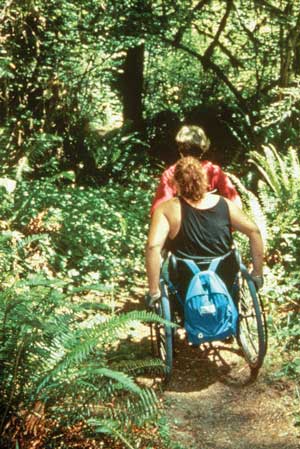
Figure 2—Two friends enjoy a trail that complies with the guidelines and allows them to hike through the rain forest.
Other phrases concerning accessibility that are not correct include: partially accessible, accessible with assistance, barrier free, ADA accessible, and handicapped accessible. A facility is either accessible or it is not accessible. If the facility is not accessible, the visitor or employee needs to know which specific areas are not accessible. "Partially accessible" and "accessible with assistance" imply some accessibility problems, but don't provide enough information to be helpful. "Barrier free" isn't legally defined or commonly understood. "ADA accessible" confuses laws with accessibility standards. "Handicapped accessible" is a common phrase, but it is offensive to many people with disabilities and should not be used. "Handicapped accessible" is also a contradiction because a handicap is a barrier and accessible means there aren't any barriers. The best terminology is simply accessible and not accessible.
Providing Appropriate Information About Accessibility
Forest Service policy is to provide nonjudgmental information about programs and facilities so that visitors may choose the areas, activities, and facilities that best meet their interests and needs. The goal is independence, integration, and dignity for all visitors.
-
When composing copy for Web sites, brochures, and other public information sources, consult with forest recreation staff or forest accessibility coordinators to ensure appropriate and accurate information is conveyed and displayed.
-
When describing a specific site or area, use the term accessible only if all facilities, constructed features, and connecting routes are in full compliance with the applicable accessibility guidelines. Accessible refers only to specific facilities, constructed features, or routes that have been constructed or altered in compliance with all of the requirements of the applicable accessibility guidelines. Electronic copies of these guidelines are available at http://www.fs.fed.us/recreation/programs/accessibility/.
-
Don't use the terms "ADA," "partially," "barrier free," or "handicapped."
-
-
Provide specific details about what people can expect to encounter. For instance, include minimum width, maximum slope, and condition of the tread surface (is it firm and stable?) on information about trails. All information is for all users.
-
Don't prejudge or assume what a person can or cannot do by adding comments such as "some people may need assistance," etc. These notes, even though well intended, are patronizing.
-
Don't assign accessibility-related difficulty levels to recreation opportunities, such as camping, boating, fishing, hiking, etc. Individuals will determine which opportunity best meets their interests and abilities after reviewing the specific information about that opportunity.
-
-
Whenever standard outdoor recreation symbols are used on maps and other information sources, use the color blue to indicate accessible units. For instance, if the tent symbol is used to show the location of campgrounds on an area map, the tent symbol indicating campgrounds with accessible units should be blue, but the tent symbol for campgrounds without accessible units should be a different color, such as brown. The legend for the map should include the information that blue indicates accessibility.
-
Don't use the international symbol of accessibility on information. This symbol only should be used on signs at six legally defined facility locations when they are in full compliance with the applicable accessibility guidelines: toilet, parking space, entrance if not the main entrance, loading zones, areas of refuge in a building, and route of egress out of a building. More information about use of the international symbol of accessibility is available in "Use of the International Symbol of Accessibility and Other Signs" of this guidebook.
-
-
On newly constructed or altered trails, whether the trail complies with the accessibility guidelines or not, include the following trail information, in addition to other information typically provided for hikers, on trailhead signs:
-
Destination and length of the trail or trail segment
-
Surface type
-
Typical and minimum tread width
-
Typical and maximum running slope
-
Typical and maximum cross slope
-
A statement that the posted information reflects the condition of the trail when it was constructed or assessed, including the date of the construction or assessment
-
Legal Requirements
The Architectural Barriers Act (ABA) became law in 1968. The act http://www.access-board.gov/the-board/laws/architectural-barriers-act-aba mandates that all facilities designed, built, altered, bought, rented, or leased by, for, or on behalf of a Federal agency must be accessible.
In 1973, the Rehabilitation Act became law. Section 504 http://www.dol.gov/oasam/regs/statutes/sec504.htm of the act applies to programs and activities that are conducted by Federal agencies and by entities that receive funding from, or operate under a permit from, Federal agencies. Section 504 requires that these programs and activities provide an equal opportunity for individuals with disabilities to participate in an integrated setting, as independently as possible. The only exception to the requirement is when the program would be fundamentally altered if changes were made solely for the purpose of accessibility. An example of a fundamental alteration to a program would be allowing use of a motor vehicle in an area not designated for motorized-vehicle use.
U.S. Department of Agriculture (USDA) implementation guidance for Section 504 is Title 7 of the Code of Federal Regulations, Part 15 (7 CFR 15) that was finalized in 1994. Subpart 15e http://www.access.gpo.gov/nara/cfr/waisidx_03/7cfr15e _03.html applies to programs conducted by the Forest Service. Subpart 15b http://www.access.gpo.gov/nara/cfr/waisidx_03/7 cfr15b_03.html applies to programs operating with Federal agency funding, under special use permits, or under other agreements with the agency. If a building or structure must be entered for someone to participate in the activity at the site, the building must be accessible.
The Americans with Disabilities Act (ADA) became law in 1990. Except for Title V, Section 508(c), ADA http://www.access-board.gov/the-board/laws/americans-with-disabilities-act-intro doesn't apply to Federal agencies' facilities and programs. Federal agencies were already required to be accessible under ABA and Section 504 of the Rehabilitation Act before ADA became law. ADA applies to State and local government services, to public accommodations such as motels and hotels, and to organizations that are open to the public. Title V, Section 508(c) of ADA applies to Federal wilderness areas. It reaffirms the 1964 Wilderness Act and clarifies that agencies aren't required to change the character of wilderness areas to provide accessibility. Section 508(c) also defines a wheelchair and states that wheelchairs meeting that definition may be used in Federal wilderness areas.
Universal Design
The best way to integrate accessibility is to use the principles of universal design. Universal design is simply designing programs and facilities to be usable by all people, to the greatest extent possible, without separate or segregated access for people with disabilities (figure 3). Using universal design principles is Forest Service policy, as stated in Forest Service Manual (FSM) 2330.3 These directives are available at http://www.fs.fed.us/im/directives/.
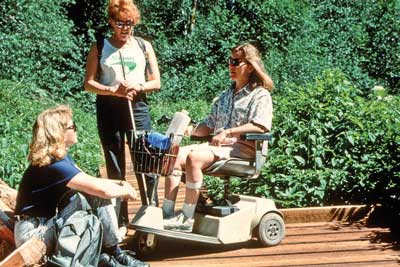
Figure 3— Friends enjoy a break during a stroll on a boardwalk through a wetlands area. A trail built on universal design principles makes it possible for a whole group to enjoy the same experience.
Since the early 1990s, the Forest Service has followed the universal design policy that all new and reconstructed facilities, programs, and associated elements are to be accessible to the greatest extent possible. This commitment often exceeds the minimum requirements of the Federal accessibility guidelines. The result of universal design is independence, integration, and dignity for everyone.
More information on accessibility guidelines is provided in the next part of this guidebook.
Program Accessibility
For the purposes of evaluating accessibility, a "program" is an activity in which people may participate. Basically, the program is the reason a person visits an area and may include opportunities such as:
-
Camping in a campground
-
Viewing the scenery at an overlook (figure 4)
-
Swimming at a beach
-
Enjoying solitude in the wilderness
-
Gathering information at a visitor center
-
Learning about an area on an interpretive trail
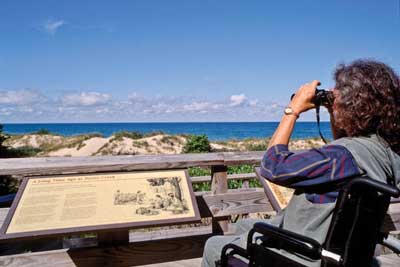
Figure 4—Interpretation is for everyone. Signs must be placed so that everyone can see and understand them.
The 1994 USDA regulations—7 CFR 15e http://www.access.gpo.gov/nara/cfr/waisidx_03/7cfr15e_03.html and 7 CFR 15b http://www.access.gpo.gov/nara/cfr/waisidx_03/7cfr15b_03.html govern USDA implementation of Section 504 of the Rehabilitation Act. They prescribe the requirements for ensuring access to programs.
If a program is provided inside a building or structure, everyone must be able to enter the facility to participate in the program. All facilities need to be constructed according to the applicable accessibility guidelines. Even historic structures are required to be as accessible as can be accomplished without destroying the historic significance of the structure. Unfortunately, some historic structures are not yet accessible, and a few cannot be made accessible without destroying their historic integrity. If a facility is not accessible, relocate the program or provide it in another manner (an alternative program). Any alternative program must allow everyone to participate together. Separate segregated programs just for people with disabilities aren't permitted. For example, if an evening program at a campground previously has been held in an amphitheater that isn't accessible, move the program to an accessible location until the amphitheater is accessible.
Under Section 504 of the Rehabilitation Act and 7 CFR 15, access to programs that don't depend on constructed facilities also are required to provide equal opportunity to all. People with disabilities may not be denied the opportunity to participate in a program if they meet the criteria to participate and their participation doesn't fundamentally alter the program. All participants must meet the essential eligibility criteria for the program and abide by any restrictions for that program in that area, including those of the forest land management plan. While all people are to have an equal opportunity to participate in programs and to strive to gain the same benefits offered by those programs, no guarantee of success is required.
The laws require equal opportunity; they don't require exceptional opportunity. For example, roads, trails, or other areas on national forests and grasslands that are not designated for motorized vehicle use under a forest travel management plan are closed to all motorized vehicles, including those used by people with disabilities.
Access to programs must be viewed through the lens of the entire program, not through the eyes of an individual. Access to the program is to be provided so long as doing so doesn't fundamentally alter the program. That is, providing access doesn't change the primary functions of the program. Allowing motor vehicles in a nonmotorized [sic] area would be a fundamental alteration of the recreation program for that area.
"Reasonable accommodation" does not apply to access to programs. Reasonable accommodation only applies in employment and involves making the modifications or adjustments to a job or the work environment so a specific qualified applicant or employee with a disability can participate in the application process or perform essential job functions. It does not apply to programs under Federal agencies, including recreation facilities and trails.
Questions often arise concerning the use of wheelchairs or other mobility devices in areas that restrict or prohibit mechanical devices or motorized vehicle use. As clarified in Title V, Section 508(c), the legal definition of a wheelchair is:
A device designed solely for use by a mobility–impaired person for locomotion that is suitable for use in an indoor pedestrian area
This is a two-part definition. "Designed solely to be used by a mobility-impaired person for locomotion" means that the wheelchair was originally designed and manufactured solely to be used for mobility by a person with a disability. The aftermarket retrofit of a motorized unit to make it usable by a person with a disability does not meet this part of the definition. The second part of the definition requires the device to be "suitable for use in an indoor pedestrian area" (figure 5). This means usable inside a home, courthouse, or other indoor pedestrian area, such as the food court of a mall.
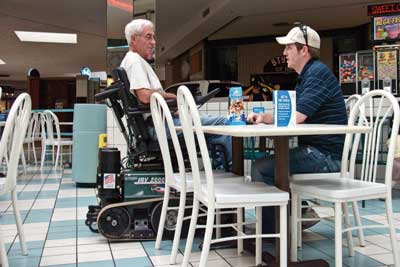
Figure 5—To meet the definition of a wheelchair, a device must be suitable for use in an indoor pedestrian area, such as this food court where two friends take a break from shopping. Like many wheelchairs, the device shown here also is useful for outdoor recreation, as shown in figure 11. Photo credit: Trac About, Inc., Newton, KS
The device must meet both parts of this definition in order for it to qualify as a wheelchair. Figures 6 through 11 show six examples of devices that meet the definition; figures 12 and 13 show two examples that do not.
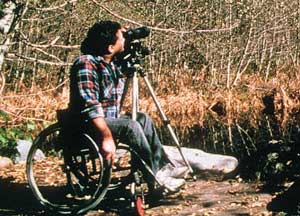
Figure 6
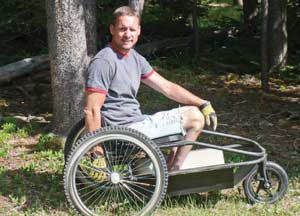
Figure 7—Photo credit: Axess Outdoors, Great Falls, MT
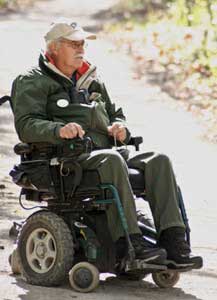
Figure 8
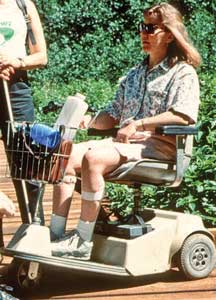
Figure 9
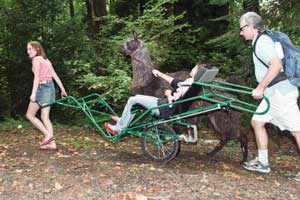
Figure 10
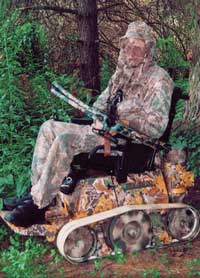
Figure 11—Photo credit: Trac About, Inc., Newton, KS
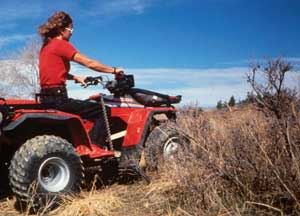
Figure 12
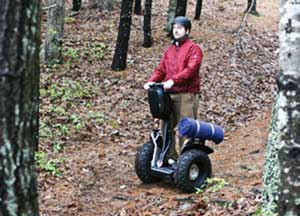
Figure 13
A person whose disability requires use of a wheelchair or mobility device may use a wheelchair or mobility device that meets both parts of the definition in the preceding paragraph anywhere foot travel is permitted in the National Forest System, in accordance with Title V, Section 508(c) of ADA; 36 CFR 212.1; and FSM 2353.05 and FSM 2320.05. Wheelchairs or mobility devices, including battery-powered wheelchairs that meet both parts of the definition, aren't categorized as motor vehicles or mechanical devices.
To determine whether a device meets the definition of a wheelchair, evaluate it against the two parts of the definition. Ask yourself the following questions:
1. Was the device designed solely for mobility by a person with a disability?
-
If "no," the device doesn't meet the definition and doesn't qualify for use as a wheelchair.
-
If "yes," ask the second question.
2. Is it suitable for use in an indoor pedestrian area? Consider whether it could be used in a mall, courthouse, or similar area without the security personnel directing the user to leave.
-
If "no," the device doesn't meet the definition and doesn't qualify for use as a wheelchair.
If the answer to both questions is "yes," the device meets the definition of a wheelchair or mobility device and may be used wherever foot travel is allowed. Some devices that don't meet both parts of the definition (see figures 12 and 13) are useful tools for some people with disabilities to move about in the outdoor environment, but they must follow the requirements for the appropriate class of motor vehicle. A "Motor Vehicle Use Map" that shows routes (roads and trails) and areas designated as open to motorized travel with allowed uses identified by vehicle class is available at national forest and national grassland offices. These maps also may be available through each forest or grassland's Web site http://www.fs.fed.us/ or through the National Forest Store Web site http://www.fs.fed.us/recreation/nationalforeststore/. Visitors can check the "Motor Vehicle Use Map" to learn where they may use devices that don't meet the definition.
Transition Plans
Since the 1968 passage of ABA, facilities designed, built, altered, bought, rented, or leased by, for, or on behalf of a Federal agency have been required to be accessible. Unfortunately, some Federal facilities are not yet accessible.
In the early 1990s, the Forest Service called for all units to complete transition plans identifying the changes needed to make each facility accessible and the timeline for completing those changes. Funding to complete the transition plans was provided to the regions in 1992, 1993, and 1994.
The regulation requiring transition plans for the existing facilities of all USDA agencies is 7 CFR 15e, section 150 "Program Accessibility: Existing Facilities." It requires a transition plan to be developed and implemented for any facility housing a program that is not accessible. The regulation required transition plans to be completed by December 31, 1997. Section 150(d) of 7 CFR http://www.access.gpo.gov/nara/cfr/waisidx_03/7cfr15e_03.html details the specific requirements for transition plans and their contents.
The transition plans covering many Forest Service areas were completed up to 20 years ago. The filed hard copies have been difficult to update and cannot be effectively entered into the National Resource Manager database that was later developed. To assure that their transition plans are current, Forest Service units are now resurveying facilities and recreation sites and recording the results electronically so that the database will contain accurate, current information.
Terminology Tip
Why wheelchairs are not motor vehicles.
In Title 36 of the Code of Federal Regulations, Part 212.1, a motor vehicle is defined as any vehicle that is self-propelled, other than:
-
A vehicle that is operated on rails
-
Any wheelchair or mobility device, including one that is battery powered, that is designed solely for use by a mobility-impaired person for locomotion, and that is suitable for use in an indoor pedestrian area
Wheelchairs that meet this legal definition may be used anywhere foot travel is allowed within the National Forest System. Mobility devices that do not meet this definition are considered to be motor vehicles within the National Forest System and may only be used where that class of motor vehicle is allowed.
No standardized format was provided in the regulation for the transition plans. Each region and some national forests developed their own transition plan format. Check with your accessibility coordinator or your regional recreation accessibility coordinator http://www.fs.fed.us/eng/toolbox/acc/documents/coord.htm#leaders or http://fsweb.mtdc.wo.fs.fed.us/toolbox/acc/documents/coord.htm (available only to Forest Service employees) or your region/station facilities program leader http://fsweb.wo.fs.fed.us/eng/documents/fac_leaders.htm (available only to Forest Service employees) to find out whether your local unit has developed a format. If not, request a sample of the formats used by other units. At a minimum, the transition plan must include:
-
A list of obstacles to accessing the facility and program as identified in the accessibility evaluation survey
-
A detailed description of the methods that will be used to provide accessibility
-
The schedule for implementing the plan, including the actions that will be taken each year if the work takes more than a year
-
The signature of the official responsible for implementation of the transition plan
Ensure transition plans are available to the public.
Accessibility Evaluation Surveys
During an accessibility evaluation survey, compare each portion of a structure to the accessibility standards, and record compliance and deficiencies. For example, check doorways to see whether they have at least 32 inches (815 millimeters) of clear width (figure 14). This information is important for developing transition plans and for providing useful information about the wide range of Forest Service facilities.
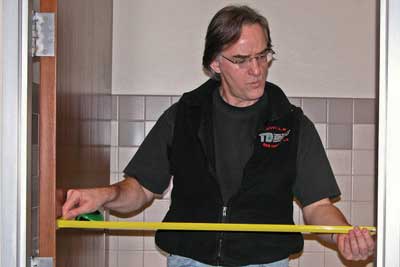
Figure 14—All doorways must have a minimum of 32 inches (815 millimeters) clear width.
A U.S. Forest Service Accessibility Database has been developed to facilitate the gathering, retention, updating, and use of the survey information. Check with your unit's accessibility coordinator or your regional recreation accessibility coordinator for more information about this database and about opportunities to have the accessibility of the recreation facilities on your unit surveyed. The Youth Conservation Corps Inclusive Toolbox Project offers one way to have surveys conducted and the resulting data entered into the accessibility database.

User Comments/Questions
Add Comment/Question